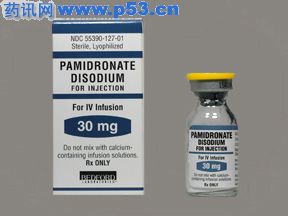| 【药品名称】 通用名:注射用帕米膦酸二钠 英文名:PAMIDRONATE DISODIUM FOR INJECTION 【主要成分】 【性状】 【药理作用】 【药代动力学】 【适应证】 【用法用量】 【不良反应】 【禁忌】 【注意事项】 【孕妇及哺乳期妇女用药】 【儿童用药】 【老人用药】 【药物相互作用】 【药物过量】 【贮藏】 【原产地英文商品名】PAMIDRONATE POWDER 30mg/10mls/Vial AREDIA (pamidronate disodium) INDICATION(S) Aredia (pamidronate disodium) is indicated for the treatment of patients with moderate to severe Paget's Disease of bone. The effectiveness was demonstrated primarily in patients with serum alkaline phosphatase ≥3 times the upper limit of normal. Aredia (pamidronate disodium) is indicated, in conjunction with standard antineoplastic therapy, for the treatment of osteolytic bone metastases of breast cancer and osteolytic lesions of multiple myeloma. IMPORTANT SAFETY INFORMATION Due to the risk of clinically significant deterioration in renal function, which may progress to renal failure, single doses of AREDIA (pamidronate disodium) should not exceed 90 mg and the duration of infusion should be no less than 2 hours. After the initial or a single dose of AREDIA, renal deterioration, progression to renal failure, and dialysis has been reported in patients. AREDIA-treated patients, particularly those with multiple myeloma and breast cancer, have reported focal segmental glomerulosclerosis (including the collapsing variant) with or without nephrotic syndrome, which may lead to renal failure, and some had gradual renal status improvement upon discontinuation of AREDIA. Serum creatinine should be assessed prior to each treatment, and those with bone metastses should have the dose withheld if renal function has deteriorated. AREDIA (pamidronate disodium) should not be used during pregnancy. Women of childbearing potential should be advised to avoid becoming pregnant. If the patient becomes pregnant or plans to breast-feed while taking this drug, the patient should be apprised of the potential harm to the fetus or baby. AREDIA is excreted intact primarily via the kidney, and the risk of renal adverse reactions may be greater in patients with impaired renal function. Caution is indicated when AREDIA is used with other potentially nephrotoxic drugs, and in multiple myeloma patients, the risk of renal dysfunction is increased when AREDIA is combined with thalidomide. Osteonecrosis of the jaw (ONJ) has been reported predominantly in cancer patients treated with intravenous bisphosphonates, including Aredia. Many of these patients were also receiving chemotherapy and corticosteroids which may be risk factors for ONJ. Postmarketing experience and the literature suggest a greater frequency of reports of ONJ based on tumor type (advanced breast cancer, multiple myeloma), and dental status (dental extraction, periodontal disease, local trauma including poorly fitting dentures). Many reports of ONJ involved patients with signs of local infection including osteomyelitis. Cancer patients should maintain good oral hygiene and should have a dental examination with preventive dentistry prior to treatment with bisphosphonates. While on treatment, these patients should avoid invasive dental procedures if possible. For patients who develop ONJ while on bisphosphonate therapy, dental surgery may exacerbate the condition. For patients requiring dental procedures, there are no data available to suggest whether discontinuation of bisphosphonate treatment reduces the risk of ONJ. Clinical judgment of the treating physician should guide the management plan of each patient based on individual benefit/risk assessment. In post-marketing experience, severe and occasionally incapacitating bone, joint, and/or muscle pain has been reported in patients taking bisphosphonates. Symptoms were generally relieved after stopping treatment, and a subset of patients had symptoms recur after rechallenge with AREDIA or another bisphosphonate. Closely monitor serum calcium, phosphate, magnesium, potassium, creatinine, and CBC, differential, and hematocrit/hemoglobin following initiation of treatment with AREDIA. Those patients with anemia, luekopenia or thrombocytopenia should be carefully monitored in the first two weeks following treatment. Asymptomatic hypophosphatemia (12%), hypokalemia (7%) hypomagnesemia (11%) and hypocalcemia (5-12%) were reported in patients treated with AREDIA. Rare cases of symptomatic hypocalcemia (including tetany) have been reported; short-term calcium therapy may be necessary. Patients with a history of thyroid surgery may have relative hypoparathyroidism that may predispose to hypocalcemia with AREDIA. In post-marketing experience, rare instances of allergic manifestations have been reported, including hypotension, dyspnea, or angioedema, and, very rarely, anaphylactic shock. The most common adverse events (>15%) in bone metastases clinical trials, regardless of causality, were as follows: Asthenia, fatigue, diarrhea, dyspepsia, fluid overload, abdominal pain, anorexia, constipation, metastases, insomnia, nausea, vomiting, urinary tract infection, skeletal pain, fever, headache, coughing, upper respiratory tract infection, anemia, granulocytopenia, myalgias, sinusitis, and dyspnea. The most common adverse events (>15%) in the Hypercalcemia of Malignancy trials, regardless of causality, include: Fluid overload, generalized pain, hypertension, abdominal pain, anorexia, constipation, nausea, vomiting, urinary tract infection, bone pain, anemia, hypokalemia, hypomagnesemia, and hypophosphatemia. The most common adverse events (>10%) in the Paget's Disease trials, regardless of causality, include: Hypertension, arthrosis, bone pain, and headache. In hypercalcemia of malignancy trials, rare cases of uveitis, iritis, scleritis, and episcleritis have been reported, and one case each of uveitis and scleritis were found to recur upon separate rechallenge. In the absence of hypercalcemia, patients at risk of calcium or vitamin D deficiency with predominantly lytic bone metastates or multiple myeloma and patients with Paget's disease of the bone should be administered an oral calcium and vitamin D supplement. |
帕米膦酸二钠注射剂(PAMIDRONATE DISODIUM)简介:
【药品名称】通用名:注射用帕米膦酸二钠英文名:PAMIDRONATE DISODIUM FOR INJECTION
【主要成分】本品主要成份为:帕米膦酸二钠。其化学名称为:3-氨基-1-羟基亚丙基-1,1-二膦酸二钠五水合物。
【性 ... 责任编辑:admin |
最新文章更多
推荐文章更多
热点文章更多 |


